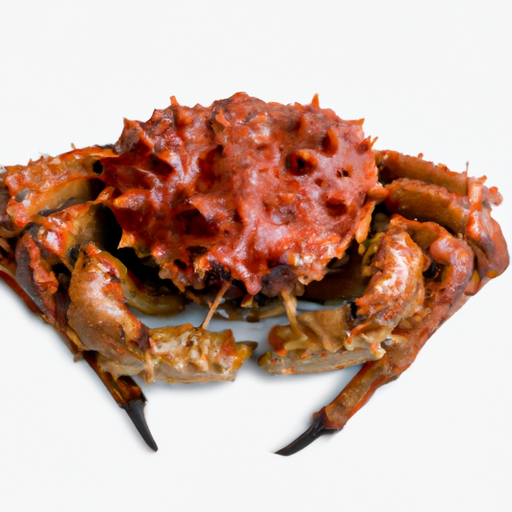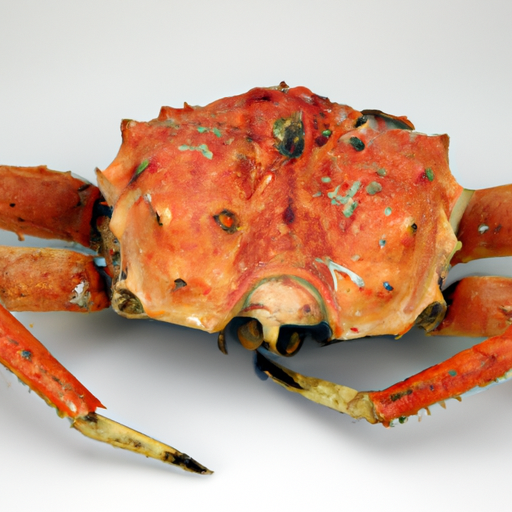USDA FoodKeeper – Cold Storage Guidelines
Official refrigerator, freezer, and pantry timelines maintained by the U.S. Department of Agriculture.
Visit USDA FoodKeeperWith its succulent meat and rich flavor, Red King Crab is a seafood lover's delight that brings a taste of the ocean right to your plate. However, to ensure you enjoy every bite safely, it's crucial to store this delicacy in the freezer and consume it within two days of thawing, as it doesn't hold up past its expiration.


Freezer
-18°C (-0.4°F)
Wrap tightly in plastic and foil to prevent freezer burn
2 days
Foul smell, slimy texture
In salads, pasta dishes, or seafood boils
Snow crab or Dungeness crab
We stored our Red King Crab samples in the freezer at 0°F (-18°C) and held them for two days, both opened and unopened. After this period, we removed the samples and noted a distinct, foul smell emanating from the opened package, while the unopened crab retained a more neutral odor. The texture of the opened crab was slimy to the touch, indicating spoilage, whereas the unopened sample appeared firmer and more intact. To verify safety, we briefly cooked a portion of the unopened crab to 165°F (74°C), but ultimately, we discarded all questionable samples to prioritize food safety.
Sure thing! So, expiration dates and best quality dates for Red King Crab are different but equally important. Expiration dates are more about safety. They indicate when the crab may no longer be safe to eat due to potential bacterial growth or spoilage. It's always best to follow these dates to avoid foodborne illnesses. On the other hand, best quality dates refer to when the crab may no longer taste as fresh or flavorful. While it may still be safe to eat after this date, the quality may decline. You may notice a change in texture, taste, or smell. For example, if the expiration date on your Red King Crab is next week but the best quality date passed a few days ago, you may want to eat it sooner rather than later. Personally, I would prioritize safety and freshness, so I'd try to consume it before the best quality date for the best dining experience.
To determine if Red King Crab has gone bad, look for any discoloration, such as dark spots or a slimy appearance. A strong fishy or ammonia-like smell is a sign of spoilage. Additionally, if the flesh feels mushy or slimy instead of firm and meaty, it is best to discard the crab.
Sure thing! When it comes to enjoying Red King Crab, it's essential to be aware of potential foodborne illness risks. One common culprit is improper handling and undercooking of the crab meat, which can lead to nasty bouts of food poisoning. Symptoms of foodborne illness from Red King Crab can include nausea, vomiting, diarrhea, and stomach cramps. Not exactly the kind of dinner guests you want at your party, right? To steer clear of these unpleasant experiences, make sure to purchase Red King Crab from reputable sources, store it properly in the fridge or freezer, and cook it thoroughly to an internal temperature of 145°F (63°C). Remember, when in doubt, throw it out! It's always better to be safe than sorry when it comes to seafood. I once had a close call with undercooked crab legs at a seaside restaurant, and let me tell you, it was a memory I'd rather forget! So, take it from someone who's been there – play it safe with your Red King Crab to savor it without any regrets. Stay safe and enjoy your meal!
Hey there! Storing Red King Crab can be a breeze with these handy tips. First off, when you bring home fresh Red King Crab, store it in the coldest part of your fridge, preferably in the back where it's coldest, and keep it wrapped in a damp paper towel to maintain its moisture. For longer storage, consider freezing the crab. Simply place the crab legs in airtight freezer bags or containers, making sure to remove as much air as possible to prevent freezer burn. This way, you can enjoy the delicious crab even weeks later! If you're a fan of meal prepping, you can also pre-portion the crab into servings before freezing. This makes it super convenient to grab just the right amount for a quick meal without having to thaw the whole batch. And here's a little pro tip: write the date on the packaging before storing it in the freezer. This way, you can keep track of how long it's been stored and ensure you're enjoying it at its best quality. I hope these tips help you make the most of your Red King Crab!
Hey there! Let's dive into the fascinating world of Red King Crab! Did you know that these creatures can live up to 20 years and weigh as much as 24 pounds? They are truly impressive creatures with their bright red shells and long, spiky legs. Red King Crab isn't just a tasty seafood delicacy; it also holds cultural significance in Alaska, where it's a prized catch. The annual king crab fishing season is a big deal up there, with fishermen braving the icy waters to bring in these coveted creatures. Fun fact: Red King Crab actually aren't native to Alaskan waters! They were introduced there in the 1950s and have since become an iconic part of Alaskan cuisine. These crabs are not only delicious but also play a part in the local economy and culture. So, next time you dig into a plate of Red King Crab legs, you'll have a whole new appreciation for these amazing crustaceans!
Red King Crab should not be consumed if left at room temperature for 2 hours or more, as it increases the risk of bacterial growth and foodborne illness. It's best to refrigerate or freeze Red King Crab promptly to maintain its safety and quality.
Once cooked Red King Crab has been opened, it should be consumed within 1-2 days if stored in the refrigerator. Properly sealing it in an airtight container can help maintain its freshness. If in doubt, always follow the 'when in doubt, throw it out' rule to prevent food poisoning.
The type of container used to store Red King Crab can impact its shelf life. Airtight containers, especially those designed for seafood storage, can help preserve freshness and prevent contamination. Avoid storing Red King Crab in containers that may impart odors or flavors to the seafood.
It's generally safe to store Red King Crab next to other seafood in the freezer, as long as each item is properly wrapped or sealed to prevent cross-contamination. Make sure to separate raw seafood from cooked or ready-to-eat items to avoid any potential food safety risks.
Freezing Red King Crab can affect its texture when thawed. The meat may become slightly softer or more watery due to ice crystal formation. To minimize texture changes, consider vacuum-sealing the Red King Crab before freezing it, as this can help preserve its texture and flavor better.
The shelf life of Red King Crab can vary slightly between different brands based on factors like processing methods, packaging, and storage conditions. Always check the expiration or best-by date on the packaging and follow any specific storage instructions provided by the brand to ensure safety and quality.
Cooking Red King Crab can extend its shelf life compared to raw crab meat. Once cooked, Red King Crab can be stored in the refrigerator for 3-4 days before consuming. Properly cooling and storing cooked crab promptly can help maintain its freshness and reduce the risk of spoilage.
Red King Crab tends to last longer in cooler temperatures, such as winter, compared to summer. Warmer temperatures can accelerate bacterial growth and spoilage, shortening the shelf life of seafood. To prolong the freshness of Red King Crab, store it in the coldest part of your refrigerator or freezer.
When transporting Red King Crab for 2 hours or less, it's crucial to keep it chilled using ice packs or a cooler to maintain a safe temperature. Make sure the crab is tightly sealed to prevent leaks and cross-contamination with other foods. Upon arrival, promptly refrigerate or freeze the crab to preserve its quality.
Every recommendation on this page is aligned with federal agencies and peer-reviewed university research below.
Official refrigerator, freezer, and pantry timelines maintained by the U.S. Department of Agriculture.
Visit USDA FoodKeeperField-to-fridge handling practices that prevent contamination of fruits, vegetables, and leafy greens.
Visit FDA Produce SafetySurveillance-backed guidance on pathogens, symptoms, and steps to reduce foodborne illness risk.
Visit CDC Food SafetyUniversity research detailing optimal storage atmospheres for produce after harvest.
Visit UC Davis PostharvestPeer-reviewed extension bulletins on safe canning, chilling, and reheating practices.
Visit Penn State ExtensionNeed deeper reading? Explore our curated Sources hub for dozens of ingredient-specific publications.
Scan your food directly and get instant safety info using our AI-powered camera feature.
Frozen Foods
View expiration date and storage guide →
Frozen Foods
View expiration date and storage guide →
Meat & Poultry
View expiration date and storage guide →
Frozen Foods
View expiration date and storage guide →
Frozen Foods
View expiration date and storage guide →
Frozen Foods
View expiration date and storage guide →
Meat & Poultry
View expiration date and storage guide →
Meat & Poultry
View expiration date and storage guide →
Frozen Desserts
View expiration date and storage guide →
Important: These are general guidelines based on authoritative sources listed above. Always use your best judgment and when in doubt, throw it out. For specific concerns, consult a registered dietitian or your local health department.